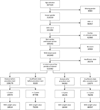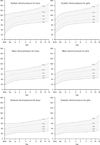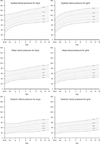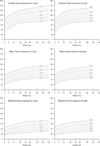Reference Values for Noninvasive Blood Pressure in Children during Anesthesia: A Multicentered Retrospective Observational Cohort Study
- PMID: 27606930
- PMCID: PMC5259808
- DOI: 10.1097/ALN.0000000000001310
Reference Values for Noninvasive Blood Pressure in Children during Anesthesia: A Multicentered Retrospective Observational Cohort Study
Abstract
Background: Although noninvasive blood pressure (NIBP) monitoring during anesthesia is a standard of care, reference ranges for blood pressure in anesthetized children are not available. We developed sex- and age-specific reference ranges for NIBP in children during anesthesia and surgery.
Methods: In this retrospective observational cohort study, we included NIBP data of children with no or mild comorbidity younger than 18 yr old from the Multicenter Perioperative Outcomes Group data set. Sex-specific percentiles of the NIBP values for age were developed and extrapolated into diagrams and reference tables representing the 50th percentile (0 SD), +1 SD, -1 SD, and the upper (+2 SD) and lower reference ranges (-2 SD).
Results: In total, 116,362 cases from 10 centers were available for the construction of NIBP age- and sex-specific reference curves. The 0 SD of the mean NIBP during anesthesia varied from 33 mmHg at birth to 67 mmHg at 18 yr. The low cutoff NIBP (2 SD below the 50th percentile) varied from 17 mmHg at birth to 47 mmHg at 18 yr old.
Conclusions: This is the first study to present reference ranges for blood pressure in children during anesthesia. These reference ranges based on the variation of values obtained in daily care in children during anesthesia could be used for rapid screening of changes in blood pressure during anesthesia and may provide a consistent reference for future blood pressure-related pediatric anesthesia research.
Figures





References
-
- DeFrances CJ, Cullen KA, Kozak LJ. National Hospital Discharge Survey: 2005 annual summary with detailed diagnosis and procedure data. Vital Health Stat. 2007;13:1–209. - PubMed
-
- [Accessed July 22, 2016]; Available at: http://www.asahq.org/quality-and-practice-management/standards-and-guide....
-
- Blake KV, Gurrin LC, Evans SF, Newnham JP, Landau LI, Stanley FJ, Beilin LJ. Reference ranges for blood pressure in preschool Australians, obtained by oscillometry. J Paediatr Child Health. 2000;36:41–46. - PubMed
-
- Neuhauser HK, Thamm M, Ellert U, Hense HW, Rosario AS. Blood pressure percentiles by age and height from nonoverweight children and adolescents in Germany. Pediatrics. 2011;127:e978–e988. - PubMed
Publication types
MeSH terms
Grants and funding
LinkOut - more resources
Full Text Sources
Other Literature Sources
Medical

